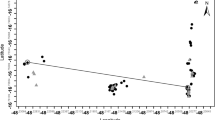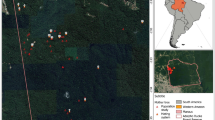Abstract
Eugenia dysenterica DC. (Myrtaceae) is a perennial tree producing edible fruits and ornamental flowers of potential value widely distributed in Brazilian “Cerrados” (savannas), but available genetic resources and potential for future breeding programs must be evaluated. Here we evaluated the reproductive system and pollen-mediated gene flow in one generation of Eugenia dysenterica germplasm collection of Agronomy School, Federal University of Goiás (in Goiânia city, Central Brazil). We collected leaves from all adults from the germplasm collection (682 plants) and seeds (542) from 23 mother-trees. Genotypes were obtained for seven microsatellite loci. Genetic diversity was high and did not significantly differ between adults (H e = 0.777) and progeny arrays (H e = 0.617). Our results showed that E. dysenterica has an allogamous mating system in the germplasm collection (t m = 0.957), but with high and significant biparental inbreeding (t m − t s = 0.109). Because sibs are very close to each other, mating between closely related individuals is likely. Paternity correlation was also relatively high, indicating a 11.9 % probability that a randomly chosen pair of outcrossed progeny from the same array are full sibs. The maximum pollen dispersal distance (224 m), estimated using assignment test, corresponded to the boundaries of the orchard. We were able to assign the paternity to only 64 % of the 349 seeds analyzed, indicating potential pollen immigration to the germplasm collection. The variance effective population size estimated for one maternal family in the germplasm collection (N ev = 3.42) is very close to the theoretical maximum value for half-sibs (Nev = 4.0). Because E. dysenterica has a long life cycle and generation time, the maintenance of an effective population size of at least 100 in the germplasm collection is suggested, which can be achieved by maintaining a seed-trees number around 30 individuals.

Similar content being viewed by others
References
Almeida Júnior EB, Chaves LJ, Soares TN (2014) Caracterização genética de uma coleção de germoplasma de cagaiteira, uma espécie nativa do cerrado. Bragantia 73:246–252. doi:10.1590/1678-4499.0075
Bittencourt JVM, Sebbenn AM (2007) Patterns of pollen and seed dispersal in a small, fragmented population of the wind-pollinated tree Araucaria angustifolia in southern Brazil. Heredity (Edinb) 99:580–591. doi:10.1038/sj.hdy.6801019
Botrel MCG, Souza AM, Carvalho D et al (2006) Caracterização genética de Calophyllum brasiliense Camb. em duas populações de mata ciliar. Rev Árvore 30:821–827. doi:10.1590/S0100-67622006000500016
Burczyk J, Adams WT, Shimizu JY (1996) Mating patterns and pollen dispersal in a natural knobcone pine (Pinus attenuata Lemmon.) stand. Heredity (Edinb) 77:251–260. doi:10.1038/sj.hdy.6880410
Chaves LJ, Vencovsky R, Silva RSM et al (2011) Estimating inbreeding depression in natural plant populations using quantitative and molecular data. Conserv Genet 12:569–576. doi:10.1007/s10592-010-0164-y
Clement CR (2001) Melhoramento de espécies nativas [Improvement of natives species]. In: Nass LL, Valois ACC, Melo IS, Valadares-Inglis MC (eds) Recursos Genéticos & Melhoramento - plantas. Fundação de Apoio à Pesquisa Agropecuária de Mato Grosso - Fundação MT, Rondonópolis, MT, pp 423–441
Cockerham CC (1969) Variance of gene frequencies. Evolution (N Y) 23:72–84. doi:10.2307/2406485
Collevatti RG, Grattapaglia D, Hay JD (2001) Population genetic structure of the endangered tropical tree species Caryocar brasiliense, based on variability at microsatellite loci. Mol Ecol 10:349–356
Collevatti RG, Estolano R, Garcia SF, Hay JD (2009) Seed abortion in the bat pollinated Neotropical tree species, Caryocar brasiliense (Caryocaraceae). Botany 87:1110–1115. doi:10.1139/B09-054
Collevatti RG, Estolano R, Garcia SF, Hay JD (2010) Short-distance pollen dispersal and high self-pollination in a bat-pollinated neotropical tree. Tree Genet Genomes 6:555–564. doi:10.1007/s11295-010-0271-4
Creste S, Neto AT, Figueira A (2001) Detection of single sequence repeat polymorphisms in denaturing polyacrylamide sequencing gels by silver staining. Plant Mol Biol Report 19:299–306. doi:10.1007/BF02772828
Doyle JJ, Doyle JL (1987) A rapid DNA isolation procedure for small quantities of fresh leaf tissue. Phytochem Bull 19:11–15. doi:10.2307/4119796
El-Kassaby YA, Askew GR (1998) Seed orchards and their genetics. In: Mandal AK, Gibson GL (eds) Forest genetics and tree breeding. CBS Publishers and Distributors, New Delhi, pp 103–111
Felfili JM, Da Silva MC, Sevilha AC et al (2004) Diversity, floristic and structural patterns of cerrado vegetation in Central Brazil. Plant Ecol 175:37–46. doi:10.1023/B:VEGE.0000048090.07022.02
Gepts P (2006) Plant genetic resources conservation and utilization. Crop Sci 46:2278. doi:10.2135/cropsci2006.03.0169gas
Goudet J (1995) FSTAT (Version 1.2): a computer program to calculate F-statistics. J Hered 86:485–486. doi:10.1371/journal.pone.0026694
Goudet J (2002) FSTAT, a program to estimate and test gene diversities and fixation indices (Version 2.9.3.2). Available at http://www.unil.ch/izea/softwares/fstat.html
Kalinowski ST, Taper ML, Marshall TC (2007) Revising how the computer program CERVUS accommodates genotyping error increases success in paternity assignment. Mol Ecol 16:1099–1106. doi:10.1111/j.1365-294X.2007.03089.x
Klink CA, Machado RB (2005) Conservation of the Brazilian Cerrado. Conserv Biol 19:707–713. doi:10.1111/j.1523-1739.2005.00702.x
Levin DA (1988) The paternity pools of plants. Am Nat 132:309. doi:10.1086/284854
Marshall TC, Slate J, Kruuk LE, Pemberton JM (1998) Statistical confidence for likelihood-based paternity inference in natural populations. Mol Ecol 7:639–655. doi:10.1046/j.1365-294x.1998.00374.x
Martins K, Chaves LJ, Buso GSC, Kageyama PY (2006) Mating system and fine-scale spatial genetic structure of Solanum lycocarpum St.Hil. (Solanaceae) in the Brazilian Cerrado. Conserv Genet 7:957–969. doi:10.1007/s10592-006-9140-y
Myers N, Mittermeier RA, Mittermeier CG, Fonseca GAB, Kent J (2000) Biodiversity hotspots for conservation priorities. Nature 403:853–858. doi:10.1038/35002501
Nei M (1978) Estimation of average heterozygosity and genetic distance from a small number of individuals. Genetics 89:583–590
Paetkau D, Calvert W, Stirling I, Strobeck C (1995) Microsatellite analysis of population structure in Canadian polar bears. Mol Ecol 4:347–354
Proença CEB, Gibbs PE (1994) Reproductive biology of eight sympatric Myrtaceae from Central Brazil. New Phytol 126:343–354. doi:10.1111/j.1469-8137.1994.tb03954.x
Rao V, Hodgkin T (2002) Genetic diversity and conservation and utilization of plant genetic resources. Plant Cell Tissue Organ Cult 68:1–19
Ritland K (1989) Correlated matings in the partial selfer Mimulus guttatus. Evolution (N Y) 43:848. doi:10.2307/2409312
Ritland K (2002) Extensions of models for the estimation of mating systems using n independent loci. Heredity (Edinb) 88:221–228. doi:10.1038/sj.hdy.6800029
Ritland K, Jain S (1981) A model for the estimation of outcrossing rate and gene frequencies using n independent loci. Heredity (Edinb) 47:35–52. doi:10.1038/hdy.1981.57
Sano EE, Rosa R, Brito JLS, Ferreira LG (2010) Land cover mapping of the tropical savanna region in Brazil. Environ Monit Assess 166:113–124. doi:10.1007/s10661-009-0988-4
Sebbenn M (2003) Tamanho amostral para conservação ex situ de espécies arbóreas com sistema misto de reprodução. Rev Inst Flor 15:147–162
Sebbenn AM, Seoane C, Kageyama PY, Vencovsky R (2000) Efeitos do manejo na estrutura genética de populações de caixeta (Tabebuia cassinoides). Sci Florest 58:127–143
Seoane C, Sebbenn AM, Kageyama PY (2005) Sistema de reprodução em duas populações naturais de Euterpe edulis M. sob diferentes condições de fragmentação florestal Mating system in two Euterpe. Sci Florest 69:13–24
Shaanker RU, Ganeshaiah KN, Bawa KS (1988) Parent-offspring conflict, sibling rivalry, and brood size patterns in plants. Annu Rev Ecol Syst 19:177–205. doi:10.1146/annurev.es.19.110188.001141
Sokal RR, Rohlf FJ (1995) Biometry: the principles and practices of statistics in biological research [Hardcover], 3rd edn. Biol Res 880
Souza EB, Naves RV, Borges JD et al (2008) Fenologia de cagaiteira (Eugenia dysenterica DC.) no estado de Goias. Rev Bras Frutic 30(4):1009–1014
Telles MPC, Coelho ASG, Chaves LJ et al (2003) Genetic diversity and population structure of Eugenia dysenterica DC. (“cagaiteira”—Myrtaceae) in Central Brazil: spatial analysis and implications for conservation and management. Conserv Genet 4:685–695. doi:10.1023/B:COGE.0000006124.55109.5e
Telles MPC, Silva JB, Resende LV et al (2013) Development and characterization of new microsatellites for Eugenia dysenterica DC (Myrtaceae). Genet Mol Res 12:3124–3127. doi:10.4238/2013.February.6.3
Trindade MG, Chaves LJ (2005) Genetic structure of natural Eugenia dysenterica DC (Myrtaceae) populations in northeastern Goiás, Brazil, accessed by morphological traits and RAPD markers. Genet Mol Biol 28:407–413. doi:10.1590/S1415-47572005000300013
Van Oosterhout C, Hutchinson WF, Wills DPM, Shipley P (2004) Micro-checker: software for identifying and correcting genotyping errors in microsatellite data. Mol Ecol Notes 4:535–538. doi:10.1111/j.1471-8286.2004.00684.x
Vencovsky R, Crossa J (2003) Measurements of representativeness used in genetic resources conservation and plant breeding. Crop Sci 43:1912. doi:10.2135/cropsci2003.1912
Weir BS (1996) Genetic data analysis II: methods for discrete population genetic data. Sinauer Associates Inc., Sunderland
Wendt SN, Sousa VA, Quoirin M (2009) Baixa taxa de contaminação de pólen, desvios de cruzamentos aleatórios e endogamia em um pomar de sementes de Ilex paraguariensis l. Sci For 37:185–196
Workman PL, Niswander JD (1970) Population studies on southwestern Indian tribes. II. Local genetic differentiation in the Papago. Am J Hum Genet 11:24–49
Zucchi MI, Brondani RPV, Pinheiro JB et al (2002) Transferability of microsatellite markers from Eucalyptus spp. to Eugenia dysenterica (Myrtaceae family). Mol Ecol Notes 2:512–513. doi:10.1046/j.1471-8278.2002.00297.x
Zucchi MI, Brondani RPV, Pinheiro JB et al (2003) Genetic structure and gene flow in Eugenia dysenterica DC in the Brazilian Cerrado utilizing SSR markers. Genet Mol Biol 26:449–457. doi:10.1590/S1415-47572003000400008
Zucchi MI, Pinheiro JB, Chaves LJ et al (2005) Genetic structure and gene flow of Eugenia dysenterica natural populations. Pesqui Agropecu Bras 40:975–980. doi:10.1590/S0100-204X2005001000005
Acknowledgments
This work was supported by several grants and fellowships to the research network PRONEX ‘‘Núcleo de Excelência em Genética e Conservação de Espécies do Cerrado’’- GECER (PRONEX/FAPEG/CNPq CP 07-2009 e CP 07-2012), GENPAC (Geographical Genetics and Regional Planning for natural resources in Brazilian Cerrado) from CNPq/MCT/CAPES (563624/2010-8) and MCT/CNPq 14/2009—Universal (475182/2009-0). E.B.R. and L.R.M. received a CNPq scholarship. We thank everyone who worked in the last 20 years to Cerrado species at the Agronomy School of UFG, especially Dr. Ronaldo Veloso Naves. Work by M.P.C.T., R.G.C. and L.J.C. has been continuously supported by productivity fellowships from CNPq.
Author information
Authors and Affiliations
Corresponding author
Electronic supplementary material
Below is the link to the electronic supplementary material.
Rights and permissions
About this article
Cite this article
Rodrigues, E.B., Collevatti, R.G., Chaves, L.J. et al. Mating system and pollen dispersal in Eugenia dysenterica (Myrtaceae) germplasm collection: tools for conservation and domestication. Genetica 144, 139–146 (2016). https://doi.org/10.1007/s10709-016-9884-3
Received:
Accepted:
Published:
Issue Date:
DOI: https://doi.org/10.1007/s10709-016-9884-3




